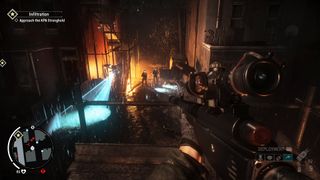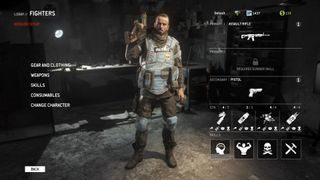Motorbikes and teamwork in Homefront's Resistance mode

Fun! I’m doing a wheelie down a ruined high street at high speed, totally unable to tell where I’m going, while heavily armed North Koreans spray machine gun fire at me. This is the best motorcycle game I’ve ever played and it’s not a motorcycle game. I drop my iron steed out of the wheelie just in time to see my surviving teammate back into the road in front of me. I can’t avoid running him down and I don’t. As his body bump-bumps under my tyres, I berate him for not obeying the Green Cross Code. It’s fine though, as I revive him under heavy fire, get back onto my bike and speed off, ignoring him, the enemies, my other downed pals, and the mission.
Homefront: The Revolution is an odd game. Though Dambuster Studios has taken the setting of the first game, it’s dumped almost everything else—understandable given it was more memorable for the amount of money THQ spent marketing it than for the quality of the game. The Revolution has a completely different premise, developer, publisher, location and quality bar. Admittedly, I’ve seen nothing of the singleplayer, but whizzing about on my motorcycle during this three-hour managed hands-on in co-op mode has got me excited. “We really want players to feel like they’re part of a resistance movement, fighting a much more numerous and equipped enemy and to have that feeling of engagement that comes from non-conventional warfare,” Stephen Rhodes, the narrative designer tells me—and I’d say this achieves that. It has that nice combination of large enemy numbers, frantic team battles and changing objectives, combined with a Payday/Left 4 Dead toughness.
It also has the same irreverent-but-functional humour. For example, when you’re creating your character, you get to choose their previous profession. I’d made a six-stone old lady as my avatar, so cage fighter seemed like an obviously dissonant choice. But I could’ve gone for panhandler, huckster, stevedore, mascot, carney... And these aren’t just silly titles—each profession gives you a bonus skill in one of the four skill trees, which is a big foot-up to getting the higher level, super-skills like Gunner.

The weapon system is also fantastic. It was only working in-mission when I played, but essentially each gun type has a wide array of mods for it, which can be changed on the fly in-game, if you’ve acquired them. But most impressively, each gun can change into two different types of gun. So with a single click, my shotgun can be rejigged into a fully automatic shotgun or an inferno launcher that fires Molotov cocktails.
We played three maps of the 12 that will be available at launch. One was an infiltration mission where we were trying to stealthily hijack two jeeps, another was a scouting mission that quickly turned into a frantic rearguard, and the third was a huge devastated townscape where we rode motorcycles between our targets, dodging drone tanks, snipers and waves of enemies. Rhodes says the team will be producing free DLC for a year after release and, “All the content we’re creating for the Resistance Mode will be completely free to everyone who has the game, so the player base will never be divided.”
I’m a bit surprised this is part of the main game, considering how promising it is. “The Resistance Mode builds upon the fiction and narrative we have in the story mode,” Rhodes explains, “so we felt they needed to come as one package to get that message across.” Fair enough—I’m not going to complain about a ton of extra free content. Just as long as I get to keep riding my dirt bike, I’ll be happy.
PC Gamer Newsletter
Sign up to get the best content of the week, and great gaming deals, as picked by the editors.
